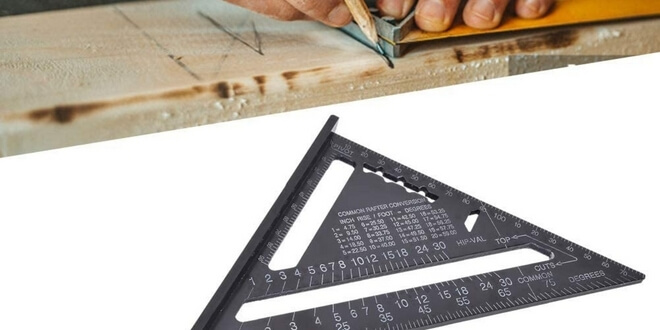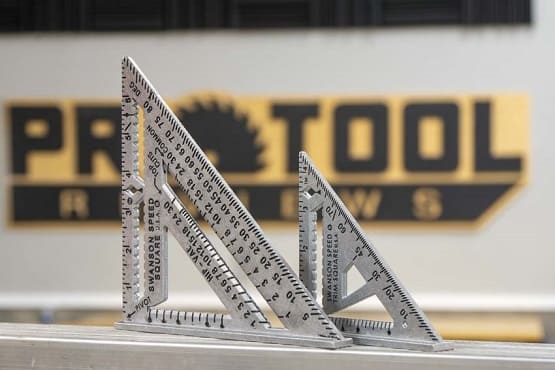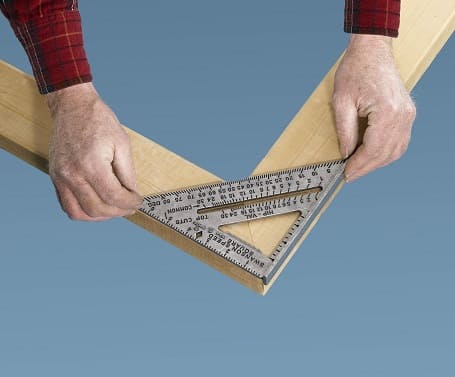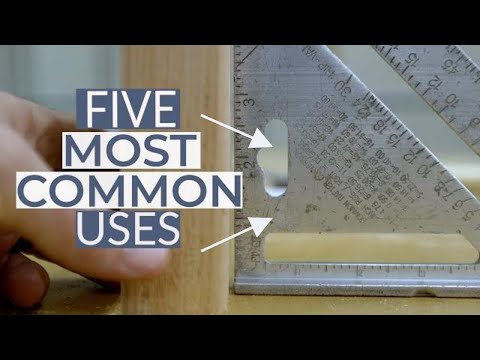
You may be really wondering what a speed square is used for, more so if you have no idea about what it is. Those who are into DIY activities and things to do with construction will probably have an idea of what a speed square is.
A speed square is an essential tool in most home and workshop projects as a carpenter, especially if you need to achieve fully accurate results. Knowing what is a speed square used for is important for the outcome increase.
Furthermore, it is important to really understand what a speed square can do for you, together with the markings on it. Without this knowledge, it will be futile to invest in one.
It has several uses and is not limited to determining the 45 and 90-degree marking when cutting material such as wood or metal. This article gives you some insight into the speed square and its uses.
What Is A Speed Square Used For?

We first need to know what a speed square is. A speed square is a marking-out tool that is triangular and is mostly used by carpenters to ensure accurate results.
One can use other names to refer to this tool, such as triangle square, rafter angle square, or rafter square. So, in case you meet these names somewhere, they basically refer to the same thing. Notably, it has been in existence since time immemorial.
It may either have plastic, steel, or aluminum material in its construction. Besides, it is quite a common tool for carpenters, and you may not miss it in their toolbox.
It can effectively perform the functions of a framing square, try square, or combination square all at once. This makes it convenient for carpentry jobs and DIY projects.
Furthermore, it has some unique features that make it work the way it does. There is a cut that is in the shape of a diamond around its edge that helps you to create a line that is ideally 90 degrees during scribing.
Other features include a fence that is lipped, numbers that are deeply engraved, cutouts, and notches. All these play a good role in ensuring it delivers excellent output.
Additionally, there are wordings on the speed square that one needs to clearly familiar with. There is the degree that outlines the degrees ranging from 0 to 90.
Common is basically used to show the increase that occurs over a 12-inch common rafter that is between inches 1 to 30.
Lastly, the Hip/Val depicts how many inches the speed square can rise over a valley or hip rafter, which is 17 inches. Also, there is a hypotenuse that lays out the degrees of the tool.
What is the main use of speed square?

1. Acts as a guide for the saw
If you are using a circular saw to cut across a piece of wood, then you must consider a speed square to garner excellent and accurate results.
You can attain precise 45- and 90-degree angle cuts if guided by a speed square.
Ensure that the fence of whatever you are working on holds securely to the boards using C-clamps that are medium in size.
Thereafter, you can glide your circular saw in opposition to the speed square and finally cut the lumber.
The speed square is suitable for use as a saw guide because it is thicker as compared to a combination or a framing square. This ensures that the saw does not slide against the speed square, hence accuracy.
Besides, it makes sure you are safe when working on your lumber. To avoid any regrettable mistakes, you can carry out a few practices till you are satisfied that you are good to go.
2. Scribing Lines
When making a rip cut on your lumber, you will need to come up with an accurate guideline to obtain good results. This is where the speed square comes in.
The lip of the speed square needs to be on the lumber’s outer edge while the tip of your pencil fits in any of the notches and begins scribing.
It is that simple! The lipped edge ensures precise angles of 45 and 90 degrees, thus giving you an easy time during scribing.
3. Pitching your roof
If you plan on replacing your roof or want to add anything to it, you will need to determine the angle of pitch of your roof. A speed square will effectively give you a simple solution if it comes with a level.
The first thing to do is align the edge of your roof with the lip of the speed square and ensure a torpedo level on its top. Achieving a center level confirms that you can quickly tell the pitch angle of your roof.
4. Protracting purposes
Protracting basically involves a speed square for reading angles and, after that, marking them to be useful for your work later. Because of the degree markings on the edge of the speed square, it becomes easy to protract.
If you need to mark an angle of 60 degrees, ensure to place the pivot point firmly in opposition to the board that you are working on.
Finish by drawing a line across the square found on the diagonal edge’s opposite side and then make the cut.
What you need before buying a speed square
Type of material
Buying a speed square with heavy metal, steel, or aluminium construction is essential. These materials ensure the durability of your tool, hence lengthening its lifespan.
There are those that feature plastic construction, especially ones used for marking. Plastic material is friendly to your hands.
Portability
A good speed square is lightweight and easy to carry from one point of the workshop to another. Most metal squares are heavier than plastic ones, depending on what you plan to use your speed square for.
FAQ
How do I choose a speed square?
Consider the brand, size, accuracy, and features when choosing a speed square. Look for a sturdy aluminium or steel square with clear etched markings from a reputable manufacturer.
Make sure the square has the angle readings you need for your projects. A 12-inch speed square is a versatile general-purpose size.
Is a speed square worth it?
A quality speed square is a worthwhile investment for any home DIYer, carpenter or woodworker. It allows quick, accurate 90 and 45-degree measurements and can be used as a saw guide.
What is the most common size speed square?
The most common and versatile speed square size is 12 inches. This provides the ability to measure 90 and 45-degree angles for many typical construction and woodworking tasks.
Smaller 7-inch squares offer portability, while larger 16-inch squares allow extended reach.
What is the #1 common use of a speed square?
The most common use of a speed square is for marking 90 and 45-degree angles. It gives quick, accurate reference lines for cutting trim, decking, rafters, etc. Speed squares are also often used as a saw guide for straight cuts.
Final Verdict
Finding out what a speed square is used for is the primary purpose of this article. If you are a carpenter, then you cannot fail to use this tool in your day-to-day activities.
It effectively puts together various functions in one simplified tool. Investing in this tool makes your work easier and more convenient. Whether you want to mark or read angles, scribe lines, or act as a saw guide, this is a must-have.
